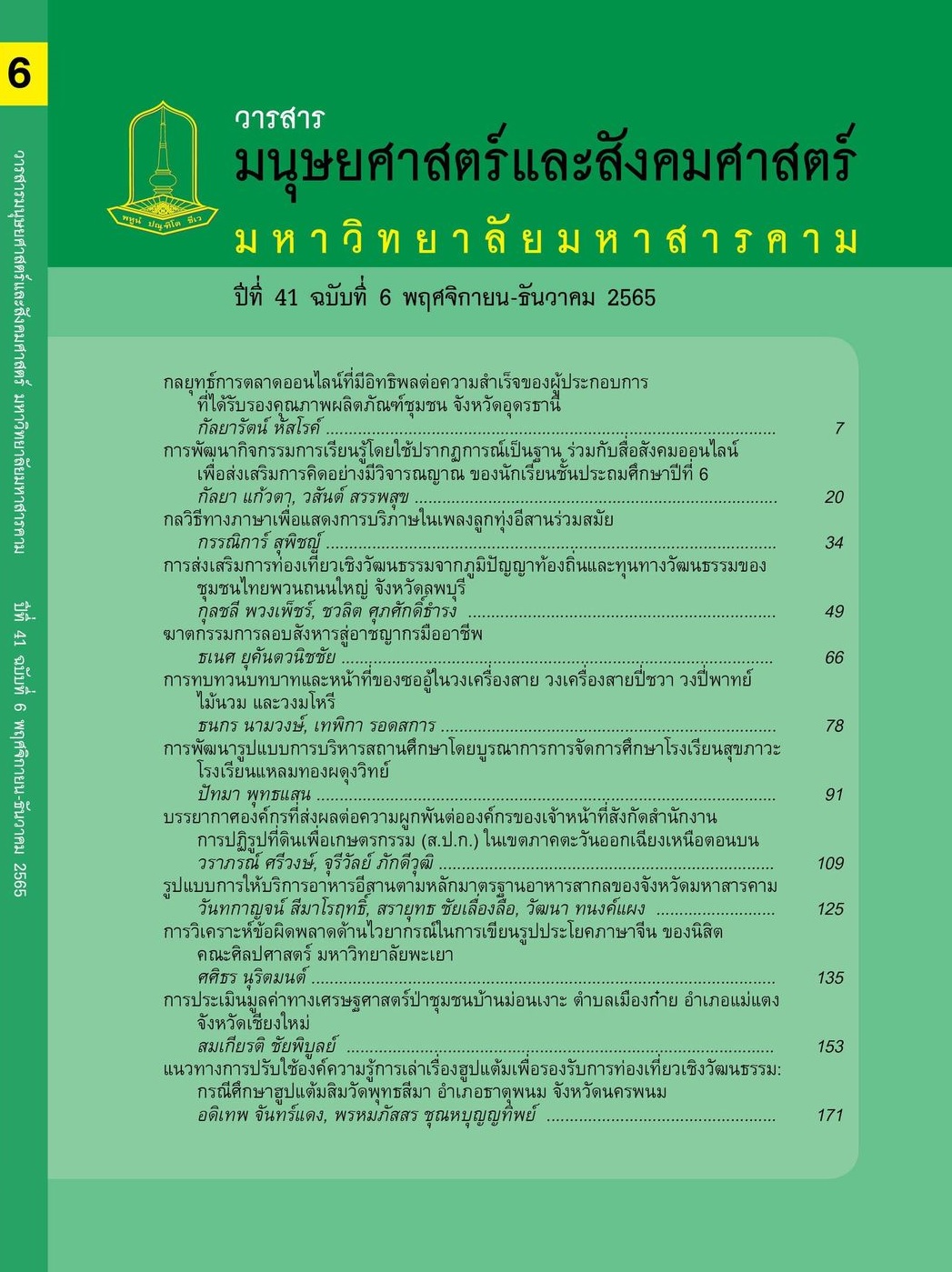แนวทางการปรับใช้องค์ความรู้การเล่าเรื่องฮูปแต้มเพื่อรองรับการท่องเที่ยว เชิงวัฒนธรรม : กรณีศึกษา ฮูปแต้มสิมวัดพุทธสีมา อำเภอธาตุพนม จังหวัดนครพนม
Main Article Content
บทคัดย่อ
การวิจัยนี้เป็นงานวิจัยเชิงคุณภาพมีจุดประสงค์ 1) ศึกษาองค์ความรู้การเล่าเรื่องจากฮุปแต้มวัดพุธสีมา 2) ศึกษารูปแบบการจัดการองค์ความรู้การเล่าเรื่องจากฮุปแต้มวัดพุธสีมา 3) เสนอแนวทางการปรับใช้องค์ความรู้การเล่าเรื่องฮูปแต้มวัดพุธสีมาเพื่อรองรับการท่องเที่ยวเชิงวัฒนธรรม เก็บรวบรวมข้อมูลโดยการสัมภาษณ์เชิงลึกจากผู้ให้ข้อมูลหลัก10 คน ใช้รูปแบบการวิเคราะห์เชิงเนื้อหาในการวิเคราะหฺข้อมูล ผลการวิจัยพบว่ารูปแบบการจัดการองค์ความรู้การเล่าเรื่องจากฮุปแต้มวัดพุธสีมามี 7 ขั้นตอน ประกอบด้วย 1) การบ่งชี้ความรู้ 2) การสร้างและแสวงหาความรู้ 3) การจัดความรู้ให้เป็นระบบ 4) การประมวลและกลั่นกรอง 5) การเข้าถึงความรู้ 6) การแบ่งปันแลกเปลี่ยนความรู้ และ 7) การเรียนรู้ และนำความรู้ไปใช้ประโยชน์ โดยมีแนวทางการปรับใช้องค์ความรู้การเล่าเรื่องฮูปแต้มเพื่อรองรับการท่องเที่ยวเชิงวัฒนธรรมด้วยการนำขั้นตอนการจัดองค์ความรู้ทั้ง 7 ขั้นตอนมาเป็นแนวทางในการสร้างเรื่องราวจากฮูปแต้มวัดพุธสีมา มาทำเป็นเรื่องเล่าอย่างเป็นระบบให้แก่นักท่องเที่ยวที่เดินทางมาเที่ยวที่วัดพุทธสีมา โดยมีปราชญ์ชาวบ้านเป็นผู้นำชม พร้อมกับได้จัดกิจกรรมถ่ายทอดองค์ความรู้เกี่ยวกับการเล่าเรื่องฮูปแต้มให้แก่เยาวชนในหมู่บ้านเพื่อเป็นอนุรักษณ์ภูมิปัญญาและองค์ความรู้การเล่าเรื่องฮูปแต้มให้คงอยู่ต่อไป
Article Details
เอกสารอ้างอิง
กรมการท่องเที่ยว กระทรวงการท่องเที่ยวและกีฬา. (2561). สถิตินักท่องเที่ยวภายในประเทศ ปี2560 จำแนกตามภูมิภาคและจังหวัด. สืบค้นจากhttp://tourism2.tourism.go.th/home/details/11/221/25767.
กรมส่งเสริมวัฒนธรรม กระทรวงวัฒนธรรม. (2559). วัฒนธรรม วิถีชีวิตและภูมิปัญญา. สืบค้นจาก http://www.culture.go.th/culture_th/article_attach/pub lication.pdf.
กระทรวงการท่องเที่ยวและกีฬา. (2560). เเผนพัฒนาการท่องเที่ยวแห่งชาติฉบบั ที่2 (พ.ศ.2560-2564). กรุงเทพฯ: สำนักงานกิจการโรงพิมพ์องค์การสงเคราะห์ทหารผ่านศึก.
กระทรวงมหาดไทย สำนักบริหารยุทธศาสตร์กลุ่มจังหวัดภาคตะวันออกเฉียงเหนือตอนบน. (2562).ยุทธศาสตร์กลุ่มจังหวัดภาคตะวันออกเฉียงเหนือตอนบน 2. สืบค้นจาก http: / / www.osmnortheast-n1 .moi.go. th/ud/index. php?option= com_ weblinks&view=category&id=36&Itemid=94.
กชมาศ แซ่เตียว, จิรารัตน์ ไมยวรรณ, พัชราพร เขียวฉะอ้อน, ภัทราวดี บำรุงวงศ์,อารียา ปานทองทา,และ ชัยณรงค์ ศรีรักษ์. (2563). การจัดการความรู้มรดกภูมิปัญญาท้องถิ่นเพื่อวางแผนกิจกรรม ท่องเที่ยวเชิงสร้างสรรค์กรณี ศึกษาชุมชนโนนทัน อำเภอเมืองจังหวัดหนองบัวลำภู| LOCAL WISDOM HERITAGE MANAGEMENT FOR CREATIVE TOURISM ACTIVITIES PLANNING: A CASE STUDY OF NON-THAN COMMUNITY AMPHOE MUEANG. วารสาร ศิลปศาสตร์ และวิทยาการจัดการ มหาวิทยาลัย เกษตรศาสตร์, 7(2), 112-120.
กิตติ์ธนัตถ์ ญาณพิสิษฐ์. (2560). สถานภาพฮูปแต้มอีสานศึกษา: อดีตจนถึงปัจจุบัน. วารสารการบริหาร ปกครอง, 6(2), 155-173.
กิจติพงษ์ ประชาชิต. (2554). วัฒนธรรมอีสานในสื่อพื้นบ้าน. Art and Architecture Journal Naresuan University, 2(1), 74-86.
จุรีรัตน์ ทวยสม. (2554). รอยวัฒนธรรมอีสาน. Journal of Fine and Applied Arts Khon Kaen University, 3(2), 38-55.
เทพพรมังธานี. (2554). ฮูปแต้มในสิมอีสาน: ภาพสะท้อนความหลากหลายของลัทธิความเชื่อ. Journal of Fine and Applied Arts Khon Kaen University, 3(1), 40-54.
พระครูสังฆรักษ์ปรีชา ฐิตญาโณ (2564). การสร้างความสัมพันธ์ระหว่างชุมชนกับวัดตามหลักสังคหวัตถุ 4. Journal of MCU Nakhondhat, 8(6), 77-87.
พระวโรตม์ นนตรี. (2561). ฮูปแต้มวรรณกรรมปฐมสมโพธิกถาในศาสนาคารอีสาน. วารสารศึกษาศาสตร์ มมร, 5(1), 164-171.
พิสิทธิ์ กอบบุญ. (2563). จิตรกรรมอีสานริมแม่น้ำโขง: พุทธศิลป์เพื่อการศึกษาเรียนรู้พุทธธรรมคุณธรรม จริยธรรมและวิถีชุมชน; Isan Murals along the Mekong: Buddhist Art Learning for Understanding Buddhist Thought, Morality, Ethics and Community Life. JOURNAL OF LANGUAGE, RELIGION AND CULTURE, 9(1), 103-137.
สุทราสินี จำปาจี. (2563). การเตรียมความพร้อมด้านทรัพยากรมนุษย์ในอุตสาหกรรมการท่องเที่ยวของ ประเทศไทยสู่ประชาคมเศรษฐกิจอาเซียน. วารสา สหวิทยาการ, 11(1), 28-57.
อดุลย์หลานวงค์, พระมหาโยธิน โยธิโกและพระภานุวัฒน์จนฺทวฑฺฒโน (2564). ฮูปแต้มอีสาน: การจัดการ ของชุมชนเพื่อการท่องเที่ยวทางพระพุทธศาสนาและวัฒนธรรม. Journal of Modern Learning Development, 5(5), 158-168.
อำภา บัวระภา. (2564). ความสัมพันธ์ของฮูปแต้มกับภูมิทัศน์ชุมชน. วารสาร สถาปัตยกรรมการออกแบบ และการก่อสร้าง, 3(1), 29-40.
Tashakkori, A., Teddlie, C., & Teddlie, C. B. (1998). Mixed methodology: Combining qualitative and quantitative approaches (Vol. 46). sage.
Williams, C. (2007). Research methods. Journal of Business & Economics Research (JBER), 5(3).


